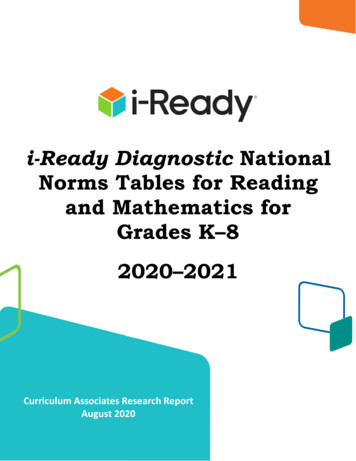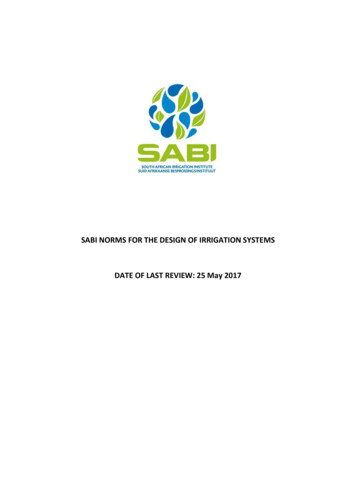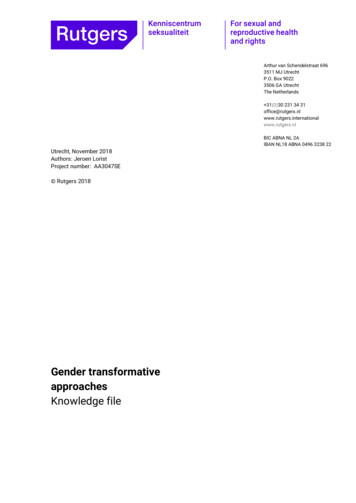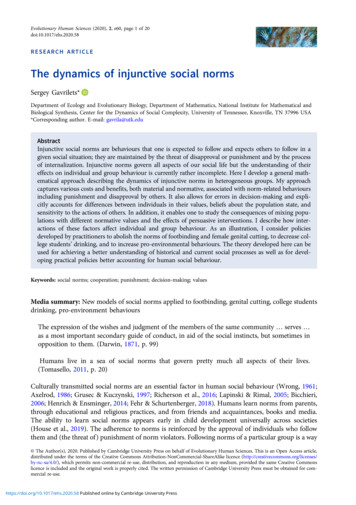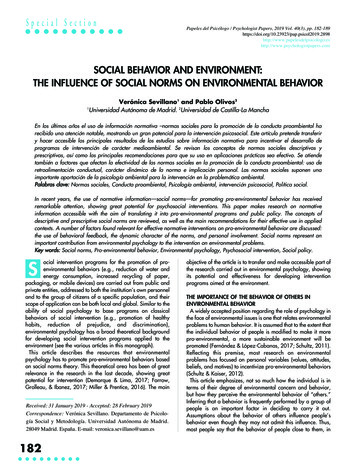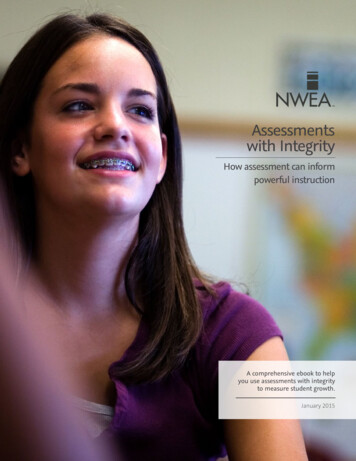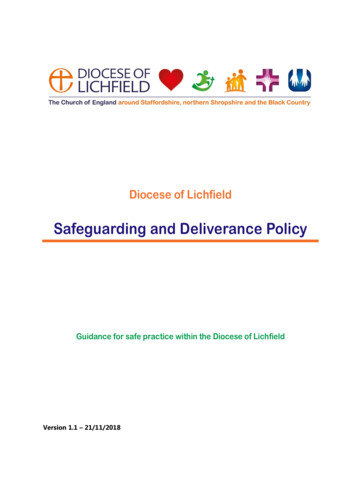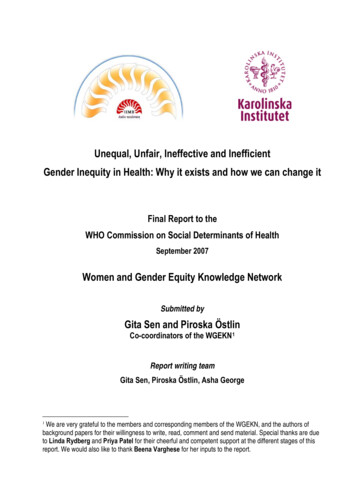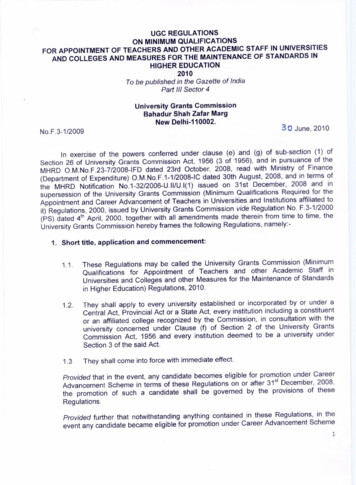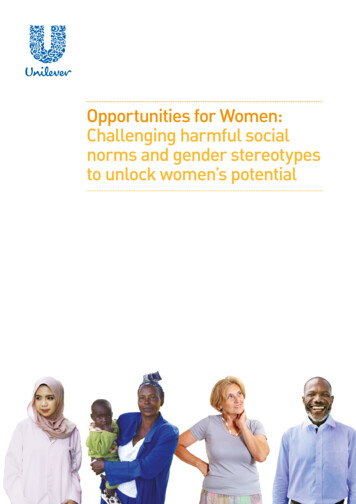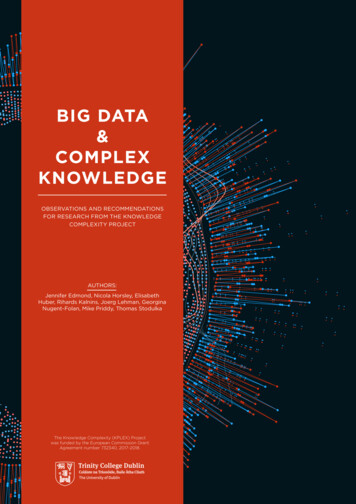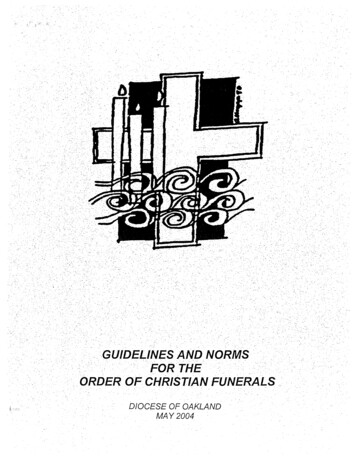
Transcription
. . · , . . . .:. r . ·.,"\. ·, · . ' . ·" .::'.:.·\··. .··- . .:".-. . . -.'·;:· . ':·-.'.·-·.·.-;-. .(.·. ;-.·. . :-.-.·.-,.-·. . . . .· .·.,··. . .·-. ·,.·. ' ';·. .- GUIDELiNES AND NORMS.·· ·.FORTHE.·. ·. ORDER OF CHRISTIAN FUNERALS .DIOCESE OF OAKLANDMAY2004' . :. . 0
DIOCESE OF OAKLAND2900 LAKESHORE A VENUE OAKLAND, CA. 94610-3614510.893.4711. FAX: 510.893.0945 www.oakdiocese.orgDECREE OF PROMULGATIONGUIDELINES AND NORMSFOR THE ORDER OF CHRISTIAN FUNERALSIN THE DIOCESE OF OAKLANDFor the People of God, hope does not disappoint. In the midst of the sadness and fatigue thatsurrounds the death of one known by God and loved by family and friends, it is our sure hopethat the Risen Lord Jesus will pattern the bodies of our brothers and sisters to conform with hisglorified body. Such transformation begins in the liturgy of Baptism when the Church, the Bodyof Christ, welcomes a person into the new life of faith on earth; in the liturgies of the funeral ·rites, the ·church accompanies those who have died in the consummation of that new life in theglory of heaven. We trulY believe, as St. Paul affirms, that our citizenship is in heaven (cf.Philippians 3: 30).The guidelines and norms for the Diocese of Oakland on the Order of Christian Funerals offerintegrated and culturally sensitive instructions for the exercise of the funeral rites, the parish'srelationship with mortuaries and the Catholic cemeteries of the Diocese of Oakland.I want to thank the Presbyteral Council and the Liturgy Resource Office of the diocese who haveprepared these guidelines and norms and have recommended them to me for review andapproval. I am happy to promulgate them and present them to the faithful of the diocese. Theywill serve as a valuable. resource to priests, deacons and lay persons involved in planning andcelebrating funerals, to cemetery personnel who contribute to the enactment of the funeral rites,and to funeral directors desiring basic guidelines for the Rites of the Catholic funeral liturgies.In order that sufficient time be provided for the study of this document and for the necessarypreparations be in place for its implementation, I hereby decree that the Guidelines and Normsfor the Order of Christian Funerals in the Diocese of Oakland will become effective onNovember 2, 2005, the Commemoration of All the Faithful Departed (All Souls Day).Given at the Chancery on this twenty-fourth day of February in the Year of Our Lord 2005.Most ReverendBishop ofOakland. 2R -rldRaYillond . s:tsTheEcclesiastical NotaryG. Breton
2Christian Funerals: Diocese of Oakland 5. 04Table of ContentsGeneral Introduction3Part I Order of Christian Funerals: Funeral RitesIntegrity of the Funeral RitesMusicLiturgical Signs and SymbolsEntitlement to the Ministry of the Churchat the Time of DeathCremationSupport of Those Who MournEcumenical NormsPresiding MinisterDonation of the Body or OrgansOther Ministers49The Vigil for the DeceasedPlace of CelebrationThe Ministerofthe VigilVestureSelection of ReadingsFuneral Liturgy .Presiding MinisterVestureThe Funeral MassPlace of CelebrationFuneral Liturgy Outside Mass .Place of CelebrationRite of CommittalPlace of CelebrationPresiding Minister1213The Structure of Worship16The Structure of Worship17VestureStructure of the RitePart II Parish Ministry, Funeral Homes and the Order of Christian Funerals .Fee ScheduleClergy Contact ListCremat onContactParish Ministry to the Family of the Deceased19Part Ill Parish Ministry, Catholic Cemeteries and the Order of Christian FuneralsContacting the Catholic CemeteryEmployee Policy for BurialThe Right and Timing of Interment at aTransfer and RefundsCatholic CemeteryDisintermentSecular CemeteriesFirst Saturday Mass and Lenten ServicesCatholic Cemetery PolicyBishop's Memorial CreditIndigent and Financial Assistance Burials21Appendix 1.1 General Norms Order of Christian Funerals Diocese of Oakland2425Appendix 2.1 The Order of Christian Funerals Stipend and Stole Fee .Fee and Stipends for Extra ClergyCantor and Accompanist FeesAppendix 3.1 Guidelines for Parish Consultation Indigent & Financial Assistance Burials 27Indigent burialsPay when AbleLimited FundsGuidelines for clergy and/or Parish Life DirectorsAppendix 3.2 Priest Burial Benefit29Appendix 3.3 Deacon and Spouse Burial Benefit30Appendix 3.4 Diocesan and Parochial Employee Burial BenefitsFinancing for Diocesan and Parochial EmployeesFinancing for Cemetery Employees31Appendix 3.5 First Saturday Mass, Lenten Liturgies & Devotions & Special MassesSources3334
Christian Funerals: Diocese of Oakland 5.043GENERAL INTRODUCTION1.The society in which we live is often uncomfortable discussing death. And still,death is the common experience that enters every home and touches all lives. Despitedeath being so common, the mystery and fear of the unknown pervades. Suchexperiences are faced by all people, including those who share faith in the paschalmystery of Jesus Christ. Yet, the richness of our Catholic Christian faith strengthens us toface the end of our earthly life with hope and confidence. We believe: "Just as Christ istruly risen from the dead and lives forever, so after death the righteous will live forever withthe risen Christ" (CCC 989). In the liturgy of Baptism, the Church welcomes a person intothe new life of faith; in the liturgy of the funeral rites the Church accompanies the faithful ontheir way to a new life of glory. This hope, rooted in the waters of baptism, is expressedsuccinctly by the Church's liturgy:Lord, for your faithful people life is changed; not ended.When the body of our earthly dwelling lies in deathWe gain an everlasting dwelling place in heaven.2.The guidelines for the Diocese of Oakland on the Order of Christian Funeralsfacilitate integrated and culturally sensitive norms for the exercise of the Funeral Rites, theparish's relationship with funeral homes and the Catholic Cemeteries of the Diocese ofOakland. Part I .of the Oakland Guidelines provides particular outline and application of theFuneral Rites. Part II maps considerations for parishes on interaction with funeral homes.Part Ill charts the links between parish life and the Catholic Cemeteries of the Diocese ofOakland.The guidelines conclude with a series of appendices appropriate to specific elements inthe guidelines.
Christian Funerals: Diocese of Oakland 5.044PART ITHE ORDER OF CHRISTIAN FUNERALS: FUNERAL RITES3.The Church through its funeral rites commends the dead to God'smerciful love and pleads for the forgiveness of their sins. At the funeral rites,especially at the celebration of the Eucharisticsacrifice the Christian community affirms and expresses the union of theChurch on earth with the Church in heaven in one great communion ofsaints. At the rite of final commendation and farewell, the communityacknowledges the reality of separation and commends the deceased to God In this way, it recognizes the spiritual bond that still exists between the livingand the dead and proclaims its belief that all the faithful will be raised up andreunited in the new heavens and the new earth, where death will be no more(OCF 6).Integrity of the Funeral Rites4.The Funeral Rites of the Order of Christian Funerals contains three related areasthat correspond to three ritual movements: "Vigil and Related Rites and Prayers," "FuneralLiturgy," and "Rite of Committal." When the rites are fully celebrated, they ritualize thejourney from life through death to fullness of life in God. To refuse any one of the ritesdenies the deceased and their family and friends the consolation offered by the Lordthrough the ministry of the Church. However, 'The Order of Christian Funerals makesprovision for the minister, in consultation with the family, to choose rites and texts mostsuitable to the situation . (OCF 43)."5.In addition to the three ritual movements, the Church provides still otheropportunities for family and friends to gather in prayer at the death of a loved one."Related Rites and Prayers" include three brief rites that may be used onoccasions of prayer with the family: "Prayers after Death," "Gathering in thePresence of the Body," 'Transfer of the Body to the Church or the Place ofCommittal." These rites are examples or models of what can be done andshould be adapted to the circumstances. (OCF 45)6.The only Catholic Funeral Rite approved for use in the Diocese of Oakland inEnglish is Order of Christian Funerals (USCCB, 2 November 1989). In Spanish, the onlyapproved rite for use in the Diocese is Ritual de Exequias Cristianas (USCCB, 2 November2001}. In languages other than English and Spanish, ritual texts approved by otherconferences of bishops are approved for use in the Diocese of Oakland. A compendium ofgeneral norms for the Diocese of Oakland is offered as an immediate reference for thepastoral minister (Appendix 1.1 ).
Christian Funerals: Diocese of Oakland 5. 045Entitlement to the Ministry of the Church at the Time of Death7.The Catholic Faithful are to be provided the funeral rites of the Catholic Church,which ordinarily include the Vigil, Funeral Liturgy and the Rite of Committal. If a familyhesitates to request a Funeral Mass, it should be explained to them during funeral planningthat the Eucharistic liturgy is the central element of the Catholic funeral rites. The Church'sfuneral rites should not be refused to a member of the Church without consultation of thediocesan bishop and in strict accordance of canon 1184.8.The Church's funeral rites should be granted to those in the Order of Catechumens.Also, the funeral rites may be offered to those who are preparing for full reception in theCatholic communion. Those who are baptized members of other Christian traditions, inthe event that their minister is not available, can be afforded elements of the Catholicfuneral rites. According to canon 1183 §2 (CIC 1983) the Church's funeral rites may becelebrated for a child who died before baptism and whose parents intended to have thechild baptized. (Cf. OCF 18).Support of those who Mourn9.More and more parishes are providing bereavement ministry in order to journey withthe mourners before, during and after the funeral rites. Together, members of the parishcommunity and Catholic cemetery personnel can provide one ministry of consolation."Members of the community should console the mourners with words of faith and supportand with acts of kindness (OCF 10). Bereavement ministry, when available, has supportedfamilies and in some cases reconciled families with the Church and a more activeparticipation in the faith community (Cf. OCF 13). These ministers of consolation may bepresent at the funeral rites to support the family and friends of the deceased. In turn,presence at the funeral rites can facilitate ongoing ministry to those who mourn. Thus, therites should be scheduled at times that permit as many of the community as possible to bepresent. (OCF 11 ). The Diocese of Oakland commends the parish community to exploresuch a pivotal ministry if one does not exist.
Christian Funerals: Diocese of Oakland 5.046Presiding Minister10.Priests, given their particular exercise of sacramental ministry for the Church,preside at the funeral rites, especially the funeral liturgy. Deacons, also as ministers ofword and charity, preside at the Vigil Liturgy and the rite of Committal. A trained laypersoncan preside at the Vigil and other related rites as well as the Rite of Committal (OCF 14 ).Other Ministers11.Family members should be encouraged to take an active part in the Funeral rites,especially those who are trained and authorized as readers, greeters and extraordinaryministers of communion. During funeral planning, parish leadership should not demandthe family exercise any ministry that is deemed too budensome. The parish communityoffering a ministry of reconciliation, healing and peace to the family and friends of thedeceased - can provide trained ministers to fulfill various roles in the enactment of theOrder of Christian Funerals.Music12.Music is integral to the funeral rites. It allows the community toexpress convictions and feelings that words alone may fail to convey. It hasthe power to console and uplift the mourners and to strengthen the unity ofthe assembly in faith and love (OCF 30).13.An instrumentalist, cantor/song leader, and choir if possible, should be present toassist and support the assembly in singing the hymns, responses and acclamations for theRites of Christian Funerals. This may require the parish to provide worship aides so thatthe gathered assembly can engage in full, active and conscious participation.14.The choice of music for the funeral rites can be a sensitive issue for all involved.The principles of liturgy as found in the Order of Christian Funerals (OCF), Music inCatholic Worship (MCW), and Liturgical Music Today (LMT) govern the choices of music.15.The music discerned and chosen should speak about our life in Christ, hope ineternal life, consolation, and resurrection; music is intended to help people pray. Jf apiece is requested that is not appropriate for the funeral rites, another time and place forthe use of this music can be offered, e.g., before or after the Vigil, a family gathering,before the funeral liturgy, or at a meal reception.
Christian Funerals: Diocese of Oakland 5.04716.As with the other rites that shape the Order of Christian Funerals, live music affordsthe gathered family and friends of the deceased the opportunity to experience part of thebroader parish community's giftedness and ministry. It is imperative to recall,The liturgy is a complexus of signs expressed by living human beings.Music, being preeminent among those signs, ought to be ''live." Whilerecorded music, therefore, might be used to advantage outside the liturgy asan aid in the teaching of new music, it should, as a general norm, never beused within the liturgy to replace the congregation, the choir, the organist orother instrumentalists (LMT 60).The parish is responsible for providing music ministry and an appropriate compensation isrequested from the families (Cf. Appendix 2.1 ).Liturgical Signs and Symbols17.Because liturgy involves the entirety of the person- body, spirit and mind- thefuneral rites afford numerous opportunities for dynamic inculturation. The Diocese ofOakland is a network of peoples and cultures. Ritual through sign and symbol can beintegrated into the funeral rites (Cf. Appendix 1).Liturgical signs and symbols affirming Christian belief and hope in thepaschal mystery are abundant in the celebration of the funeral rites, but theirmultiplication or repetition should be avoided. Care must be taken that thechoice of signs and symbols are in accord with the culture of the people(OCF 21).Cremation18.The funeral liturgy proceeds by means of signs that are perceptible to the humansenses. The body of a deceased Christian is reverenced as a temple of the Holy Spirit,even in death. The present Code of Canon Law strongly recommends that the custom ofburying bodies be observed. However, cremation is not forbidden unless chosen forreasons that are not harmonious with Christian teaching (Can. 1176, par. 3). If cremationis chosen, the Church encourages that the body be present for the Vigil and FuneralLiturgy. Cremation follows. If this is not possible, then the cremated remains may bebrought to the funeral liturgy.19.The cremated remains are to be treated with respect and reverence. They shouldbe kept in an appropriate urn or container that is placed during the Rite of Committal in amausoleum, columbarium or proper grave. The Order of' Christian Funerals' appendix forCremation with Reflections on the Body, Cremation, and Catholic Funeral Rites providesguidelines for the celebration of the funeral liturgy when cremation takes place followingthe Funeral Liturgy and for the Funeral Liturgy in the Presence of the Cremated Remains,
Christian Funerals: Diocese of Oakland 5. 048as well as adaptations for the liturgy when cremation and committal take place before theFuneral Liturgy. Additional texts for use when the Funeral Liturgy is celebrated in thepresence of the cremated remains can be found in the appendices.Ecumenical Norms20.Ecclesial communion finds its ground in the intimate life of God brought to visibilityin Eucharistic communion. Fidelity to the Spirit of communion demands that we not simplyaccommodate divisions between churches and other ecclesial communities not in fullcommunion with the Catholic Church, but that we strive to be one. Because of ourimperfection, ministers may offer an appropriate word to the gathered assembly onreception of the Body and Blood of Christ. While the visible communion will always befragile and imperfect we are called through the grace of God to foster the visible unity ofthe Body of Christ.21.As we strive to strengthen our communion, the Diocese of Oakland offers certainecumenical norms that are not an accommodation to divisions, but a pastoral action thatworks toward a hoped-for unity of churches and communities. Catholic clergy and trainedlay persons may, when requested by the family and after consultation with proper pastor ofthe deceased, participate in the funeral services conducted by the minister of thedeceased. Catholic clergy, out of respect for other ecclesial communities, may not officiateat funerals from that tradition. Catholic clergy may officiate at committal rites in other thanCatholic cemeteries, both for Catholics and members of other churches. Clergy of otherchurches or communities may offer prayers or share reflections during the Funeral Mass, ifinvited by the family, but they may not exercise a role in the Liturgy itself.Donation of the Body or Organs22.Modern medical science has made if possible for organs to be taken from ourbodies after death to save the health and lives of others. Such organ donation is not onlypermissible but commendable. It is also permissible for persons to donate their bodies forscientific research. In such cases, the bodies of the deceased and all portions are to behandled with the greatest respect and pastoral decisions must be made to celebrateeffectively the appropriate funeral rites, including a Rite of Committal at an appropriatetime, in accord with the sound judgment of those who are professionally responsible.
'Christian Funerals: Diocese of Oakland 5. 049The Vigil for the Deceased23.The vigil for the deceased is the principal rite celebrated by theChristian community in the time following death and before the funeral liturgy,or if there is no funeral liturgy, before the rite of committal (OCF 54).Introduction24.The OCF contains two clear options: The Vigil for the Deceased and the Vigil for theDeceased with Reception at the Church. A further option for those involved in funeralplanning is to utilize prayers of the Office for the Dead (Cf. OCF 54).Place of Celebration25.The vigil may be celebrated in the home of the deceased, in thefuneral home, parlor or chapel of rest, or in some other suitable place. It mayalso be celebrated in the church, but at a time well before the funeral liturgy,so that the funeral liturgy will not be lengthy and the liturgy of the wordrepetitious. (OCF 55).On many occasions, the vigil serves as the central event the evening before the26.funeral when the family and friends gather to honor the body of the deceased, to sharewith one another and to console one another in prayer. In many instances in recent times,the family has chosen to omit the vigil all together and to simply gather quietly as a familythe night before the funeral liturgy. The parish ministers can use this opportunity to explainthe importance of the three principal ritual movements -Vigil and related Rites andPrayers, Funeral liturgy, and Rite of Committal. In some cases according to pastoral need,the minister and family may determine "from within these groups of rites those that bestcorrespond to the particular needs and customs of the mourners" (OCF 50).
Christian Funerals: Diocese of Oakland 5. 041027.In the vigil for the deceased with reception at the church, the rite of receptionshapes the introductory rites. In this case the family and others who have accompaniedthe body are greeted at the entrance of the church. The body is sprinkled with holy water,and, if it is the custom, the pall is placed on the coffin by family members, friends or theminister, etc. (Cf. OCF 82-86).In the event of an open casket for viewing at the Church, the family and the28.deceased are greeted at the door using a simple greeting to offer the compassion andmercy of Christ to the mourners. The coffin and mourners enter the Church. The Invitationto Prayer follows. Sprinkling the body and those gathered with Holy Water, placing of thepall and other Christian Symbols takes place at the funeral liturgy instead of the Vigil dueto the open casketThe Minister of the Vigil29.The ordinary minister of the Vigil is a priest or deacon. A trained layperson canpreside at the Vigil. The minister of the Vigil should be discussed with the family so thatthey are not unaware of who will be leading them in prayer.Vesture30.When the Vigil is celebrated in the Church, the proper vesture for the priest ordeacon would be alb or surplice and stole. For a layperson, clothing appropriate to cultureand/or parish custom is advised. In the funeral parlor, or some other venue, clergy andlaypersons should use discretion when determining proper vesture: a clerical suit or alband stole for the priest; coat and tie or alb and stole for the deacon; for the layperson,clothing appropriate to culture and/or parish custom is advised.Selection of Readings31.It is always advisable to have the family as involved as possible in choosing thereadings and prayers used at all the vigil. However, no pressure should be put upon themto be involved in selecting readings or serving as a lector for the vigil. The parish canprovide trained lectors for the Vigil to aid the family and friends of the deceased as well asillustrate the parish's solicitude for those who grieve (Cf. OCF 66).
f:hristian Funerals: Diocese of Oakland 5.0411Devotional Practices and Cultural Rituals32.There are certain devotional and ritual practices particular to specific generational,national or ethnic groups. Oftentimes, these particular practices afford those gathered anopportunity to enter more deeply into our Christian faith. As long as these rituals are inconformity with faith in the paschal mystery, the vigil can be an appropriate venue for theirincorporation. Such rituals can precede the vigil or take place after the concluding prayerof the Vigil. In addition, during funeral planning the ministers can encour ge particulargroups to celebrate various prayer services for the deceased at distinct times within thewaking period and before the funeral liturgy. Not all rites and devotional practices need beincluded in the Vigil itself.33.For many generations, the vigil was simply referred to as "the Rosary." This form ofprayer was standard for many years and some Catholics are not familiar with the morerecent rites of the Church, especially the Vigil. "The Rosary" is no longer the approved ritefor the Vigil. The Liturgy of the Word is now normative according to the Order of ChristianFunerals. However, adaptation to local circumstances and sensitivity to the family of thedeceased may warrant some inclusion of the rosary, in whole or in part. The Churchcommends the rosary as an opportunity to gather for prayer before or after the Vigil. Thisis particularly true when the deceased and/or their family have a life-long devotion to thisform of prayer. When the prayer of the rosary is used in any way, some brief explanationof it needs to be given for the sake of people present who do not share the Catholic faith orwho are not familiar with this form of meditative prayer.Music34.Music is vital to any vigil. "Whenever possible, an instrumentalist and a cantor orleader of song should assist the assembly's full participation in the singing" (OCF 68).Preference should be given to a gathering hymn and the psalm.Shared Reflections and Remembrances35.Based upon pastoral need, the vigil is an appropriate time for family and friends toshare stories and remembrances of the deceased. This can be incorporated into the Ritefollowing the Liturgy of the Word and homily and before the general intercessions. Also,reflections can be shared after the concluding prayer and in this case can be relativelyopen-ended. It is preferred that the reflections provide an opportunity to remember theperson's life on earth as a witness to our living faith in the paschal mystery.
Christian Funerals: Diocese of Oakland 5.0412Funeral Liturgy36.At the funeral liturgy the community gathers with the family and friendsof the deceased to give praise and thanks to God for Christ's victory over sinand death, to commend the deceased to God's tender mercy· andcompassion and to seek strength in the proclamation of the paschal mystery(OCF 129).Introduction37.The funeral liturgy, the central liturgical celebration for the deceased may becelebrated in either of two forms: Funeral Mass or Funeral Liturgy Outside Mass. TheFuneral Mass is the usual and preferred form for active practicing Catholics in the Dioceseof Oakland.· Both forms of the funeral liturgy include a Reception of the body at the Church(if this is the first time the body has been brought to the Church or if the reception could notbe done at the Vigil at the Church due to an open casket), Liturgy of the Word, and FinalCommendation and Farewell.Presiding Minister38.Priests are the ordinary ministers for the funeral liturgy. A deacon can preside atthe Funeral Liturgy Outside Mass.Vesture39.For the Funeral Mass appropriate vesture for the priest is alb, stole and chasuble.When the Funeral Liturgy Outside Mass is celebrated in the church, the proper vesture forthe priest or deacon is the alb with stole appropriate to the clerical office. A cope may beworn in addition to alb and stole.· The liturgical color chosen for the Diocese of Oakland ispreferably white. Given cultural circumstances, other colored vestments can be wornbased upon unique pastoral need. In a funeral home or other location where the FuneralLiturgy Outside Mass is celebrated, the proper vesture is a clerical suit for the priest. Forthe deacon, clothing in accord with the culture and dignity of the presidential role isdesired.
· Christian Funerals: Diocese of Oakland 5. 04The Funeral Mass40.When one of its members dies, the Church encourages thecelebration of the Mass. In the proclamation of the Scriptures, the savingword of God through the power of the Spirit becomes living and active in theminds and hearts of the community. Having been strengthened at the tableof God's word, the community calls to mind God's saving deeds and offersthe Father in the Spirit the Eucharistic sacrifice of Christ's Passover fromdeath to life, a living sacrifice of praise and thanksgiving, of reconciliation andatonement. Communion nourishes the community and expresses its unity.In communion, the participants have a foretaste of the heavenly banquet thatawaits them and are reminded of Christ's own words: 'Whoever eats myflesh and drinks my blood shall live forever" (John 6:55). Confident of Jesus'presence among them in the living word, the living sacrifice, the living meal,those present in union with the whole Church offer prayers and petitions forthe deceased, whom they entrust to God's merciful love (OCF 154).13
, Christian Funerals: Diocese of Oakland 5.0414Place of Celebrationi. \41.As a communal action of the parish, the Funeral Mass is ordinarily celebrated in theparish church to which the deceased belonged, the oratory of a religious community, or theoratory of a Catholic long-term care facility. It is possible to choose any Catholic church forthe Funeral Mass, provided the pastor of that church agrees and the pastor of thedeceased is notified (Cf. CIC 1177). The Funeral Mass is not to be celebrated in thefuneral home or mausoleum. The Funeral Mass may be celebrated on any day of the yearexcept Holy Thursday, Good Friday, Holy Saturday, Easter Sunday, the Sundays ofAdvent, Lent and Easter, and holy days of obligation (Cf. GIRM 380-1 ). General law,determines that a funeral Mass should not take place on any Sunday during the liturgicalyear.The Structure of Worship42.The Introductory Rites of the Funeral Mass invite the community to gather aroundthe Easter candle, water, the pall, the cross and the Word (Cf. OCF 35-38), symbolscentral to baptism and the life of the Christian community. These rites presume a greetingof the mourners who await and I or accompany the body in procession. Ritual planningmust take into account the structure of the liturgy, the size of the assembly and thearchitecture of the church, so that all may see, hear and experience what is going on atthis time. If the reception of the body is celebrated, precedence is given to the signs andsymbols used for the Church's liturgy. When reception of the body takes place in thevestibule, the gathered community should be in the Church and the presiding minister mayinvite the assembly to face the Church's entrance.43.Accordingly, the following must be remembered during funeral planning: Nationalflags, flower sprays on the casket or other insignia are to be respectfully removed from thecoffin at the entrance to the church; they may be replaced after the coffin is taken from thechurch (cf. OCF 38, 132). Other momentos that rest on the lid of the casket should begiven to the family or the funeral directors.11The Word of God is announced through readings which "proclaim the paschal44.mystery! teach remembrance of the dead! convey the hope of being gathered together inGod S kingdom! and encourage the witness of Christian life (OCF 22). The Word isfollowed by a brief h
7. The Catholic Faithful are to be provided the funeral rites of the Catholic Church, which ordinarily include the Vigil, Funeral Liturgy and the Rite of Committal. If a family hesitates to request a Funeral Mass, it should be explained to them during funeral planning that the Eucharistic liturgy is the central element of the Catholic funeral .
